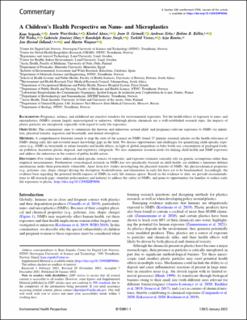A Children’s Health Perspective on Nano- and Microplastics
| dc.contributor.author | Sripada, Kam | |
| dc.contributor.author | Wierzbicka, Aneta | |
| dc.contributor.author | Abass, Khaled | |
| dc.contributor.author | Grimalt, Joan O. | |
| dc.contributor.author | Erbe, Andreas | |
| dc.contributor.author | Röllin, Halina B. | |
| dc.contributor.author | Weihe, Pál | |
| dc.contributor.author | Díaz, Gabriela Jiménez | |
| dc.contributor.author | Singh, Randolph Reyes | |
| dc.contributor.author | Visnes, Torkild | |
| dc.contributor.author | Rautio, Arja | |
| dc.contributor.author | Odland, Jon Øyvind | |
| dc.contributor.author | Wagner, Martin | |
| dc.date.accessioned | 2023-02-09T13:02:04Z | |
| dc.date.available | 2023-02-09T13:02:04Z | |
| dc.date.created | 2022-01-28T16:19:28Z | |
| dc.date.issued | 2022 | |
| dc.identifier.citation | Environmental Health Perspectives. 2022, 130 (1), . | en_US |
| dc.identifier.issn | 0091-6765 | |
| dc.identifier.uri | https://hdl.handle.net/11250/3049739 | |
| dc.description.abstract | Background: Pregnancy, infancy, and childhood are sensitive windows for environmental exposures. Yet the health effects of exposure to nano- and microplastics (NMPs) remain largely uninvestigated or unknown. Although plastic chemicals are a well-established research topic, the impacts of plastic particles are unexplored, especially with regard to early life exposures. Objectives: This commentary aims to summarize the knowns and unknowns around child- and pregnancy-relevant exposures to NMPs via inhalation, placental transfer, ingestion and breastmilk, and dermal absorption. Methods: A comprehensive literature search to map the state of the science on NMPs found 37 primary research articles on the health relevance of NMPs during early life and revealed major knowledge gaps in the field. We discuss opportunities and challenges for quantifying child-specific exposures (e.g., NMPs in breastmilk or infant formula) and health effects, in light of global inequalities in baby bottle use, consumption of packaged foods, air pollution, hazardous plastic disposal, and regulatory safeguards. We also summarize research needs for linking child health and NMP exposures and address the unknowns in the context of public health action. Discussion: Few studies have addressed child-specific sources of exposure, and exposure estimates currently rely on generic assumptions rather than empirical measurements. Furthermore, toxicological research on NMPs has not specifically focused on child health, yet children’s immature defense mechanisms make them particularly vulnerable. Apart from few studies investigating the placental transfer of NMPs, the physicochemical properties (e.g., polymer, size, shape, charge) driving the absorption, biodistribution, and elimination in early life have yet to be benchmarked. Accordingly, the evidence base regarding the potential health impacts of NMPs in early life remains sparse. Based on the evidence to date, we provide recommendations to fill research gaps, stimulate policymakers and industry to address the safety of NMPs, and point to opportunities for families to reduce early life exposures to plastic. | en_US |
| dc.language.iso | eng | en_US |
| dc.publisher | National Institute of Environmental Health Sciences (NIEHS) | en_US |
| dc.relation.uri | https://ehp.niehs.nih.gov/doi/10.1289/EHP9086 | |
| dc.subject | Miljøeffekter | en_US |
| dc.subject | Environmental effects | en_US |
| dc.subject | Barnehelse | en_US |
| dc.subject | Child health | en_US |
| dc.subject | Risikovurdering | en_US |
| dc.subject | Risk assessment | en_US |
| dc.subject | Mikroplast | en_US |
| dc.subject | Microplastic | en_US |
| dc.title | A Children’s Health Perspective on Nano- and Microplastics | en_US |
| dc.title.alternative | A Children’s Health Perspective on Nano- and Microplastics | en_US |
| dc.type | Peer reviewed | en_US |
| dc.type | Journal article | en_US |
| dc.description.version | publishedVersion | en_US |
| dc.subject.nsi | VDP::Andre helsefag: 829 | en_US |
| dc.subject.nsi | VDP::Other health sciences: 829 | en_US |
| dc.source.pagenumber | 15 | en_US |
| dc.source.volume | 130 | en_US |
| dc.source.journal | Environmental Health Perspectives | en_US |
| dc.source.issue | 1 | en_US |
| dc.identifier.doi | 10.1289/EHP9086 | |
| dc.identifier.cristin | 1992810 | |
| dc.relation.project | Norges forskningsråd: 303369 | en_US |
| dc.relation.project | Norges forskningsråd: 288638 | en_US |
| dc.relation.project | SINTEF AS: Strategic institute project on immunotherapy 102020958 | en_US |
| dc.relation.project | EC/H2020/Marie Skłodowska-Curie grant agreement 860720 | en_US |
| cristin.ispublished | true | |
| cristin.fulltext | original | |
| cristin.qualitycode | 2 |
